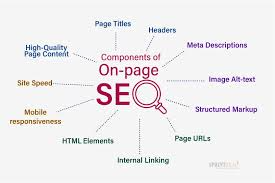Search Engine Optimization (SEO) is the process of optimizing a website to improve its visibility on search engines like Google, Bing, and Yahoo. The goal is to rank higher in search engine results pages (SERPs) for specific keywords, leading to increased organic (non-paid) traffic.
Key Components of SEO:
- Keyword Research:
Identifying the most relevant and valuable keywords for your website or content is crucial. These are the words or phrases that users enter into search engines when looking for information. Using tools like Google Keyword Planner, SEMrush, or Ahrefs, you can discover keywords that have good search volume and are relevant to your content. - On-Page SEO:
This involves optimizing elements on your website to make it more search-engine-friendly. Key factors include:
- Title Tags: Include target keywords in your page titles. This helps search engines understand what your page is about.
- Meta Descriptions: These are brief summaries of your page that appear in SERPs. They should be compelling and include keywords.
- Headers (H1, H2, H3, etc.): Proper use of header tags helps structure your content and signals important information to search engines.
- URL Structure: Use clean, readable URLs with relevant keywords.
- Internal Linking: Linking to other pages within your website helps distribute page authority and improves navigation for both users and search engines.
- Content Quality:
High-quality content that provides value to the user is critical. Search engines prioritize content that is:
- Relevant and informative
- Fresh and updated regularly
- Structured with proper formatting (bullet points, short paragraphs, etc.)
- Engaging, with multimedia like images or videos
- Technical SEO:
Optimizing the backend of your site is essential for search engine crawlers. Technical SEO includes:
- Page Load Speed: Faster-loading pages rank better.
- Mobile-Friendliness: With Google’s mobile-first indexing, having a responsive site is crucial.
- XML Sitemaps: Submit an XML sitemap to help search engines index your site.
- Robots.txt: This file tells search engines which pages to crawl and which to ignore.
- Off-Page SEO:
Off-page SEO refers to actions taken outside your website to improve its rankings, such as:
- Backlinks: High-quality backlinks from authoritative sites signal trustworthiness and improve your rankings.
- Social Media: While not a direct ranking factor, social signals can drive traffic and increase brand awareness.
- User Experience (UX):
A well-structured, easy-to-navigate site enhances the user experience and can improve your SEO. Key elements include:
- Clear Navigation: Ensure users can easily find what they are looking for.
- Mobile Optimization: Make sure your website works well on smartphones and tablets.
- Bounce Rate & Dwell Time: Search engines take note of how long users stay on your site. A low bounce rate and longer dwell time signal that your content is relevant and valuable.
- Local SEO:
If your business operates locally, optimizing for local searches is important. Key factors include:
- Google My Business Profile: Keep your business profile up to date with accurate information.
- Local Keywords: Use location-based keywords in your content.
- Online Reviews: Positive reviews help boost local rankings.
SEO Best Practices:
- Avoid Keyword Stuffing: Using keywords too many times can lead to penalties from search engines.
- Focus on User Intent: Understand what the user is searching for and provide the best content to match their intent.
- Regularly Update Content: Keeping content fresh and relevant signals that your website is active and useful.
SEO is an ongoing process, and it often takes time to see results, but with consistent effort, it can significantly increase your site’s visibility and drive long-term success.





